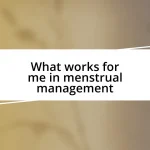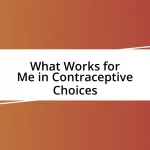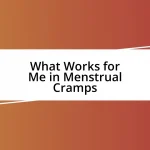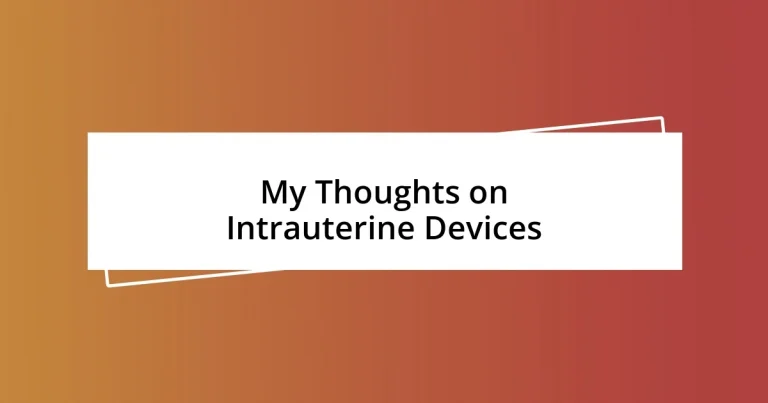Key takeaways:
- IUDs are effective long-term contraceptive devices that can also alleviate menstrual symptoms, catering to individual health needs.
- The choice between hormonal and non-hormonal (copper) IUDs depends on personal preferences, health considerations, and lifestyle goals.
- Caring for an IUD involves regular checks, maintaining follow-up appointments, and open communication with healthcare providers for ongoing comfort and reassurance.
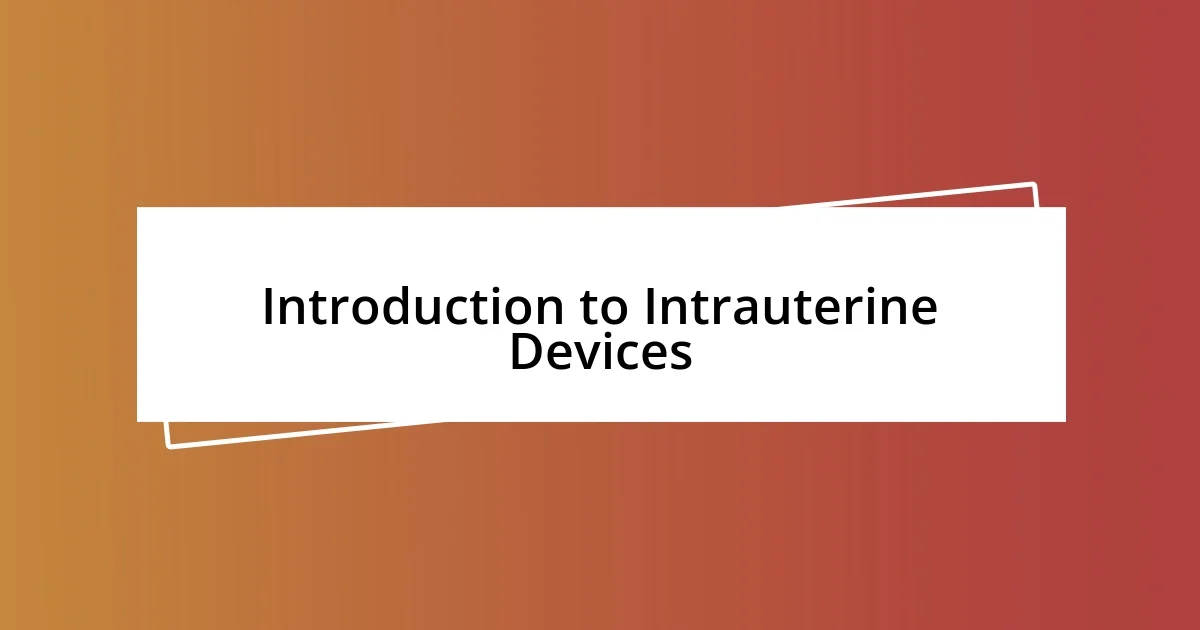
Introduction to Intrauterine Devices
Intrauterine devices (IUDs) are small, T-shaped devices that are inserted into the uterus to prevent pregnancy. I still remember the mix of curiosity and apprehension I felt when first learning about IUDs; the idea of long-term contraception seemed almost too easy. But what fascinated me was how these devices could work for years, offering a reliable option for women who seek freedom from daily contraceptive routines.
Each IUD can be hormonal or non-hormonal, offering options based on personal needs and health conditions. I once met a friend who found relief from heavy periods after opting for a hormonal IUD; she marveled at how it transformed her monthly experience. Isn’t it incredible how one small device can change so much about a person’s life?
The process of getting an IUD can be a bit daunting, yet the benefits often outweigh the initial discomfort. I remember chatting with someone who had just gone through the insertion and described it like a quick but impactful experience. It got me thinking: how often do we let a moment of anxiety prevent us from pursuing something that could improve our quality of life?
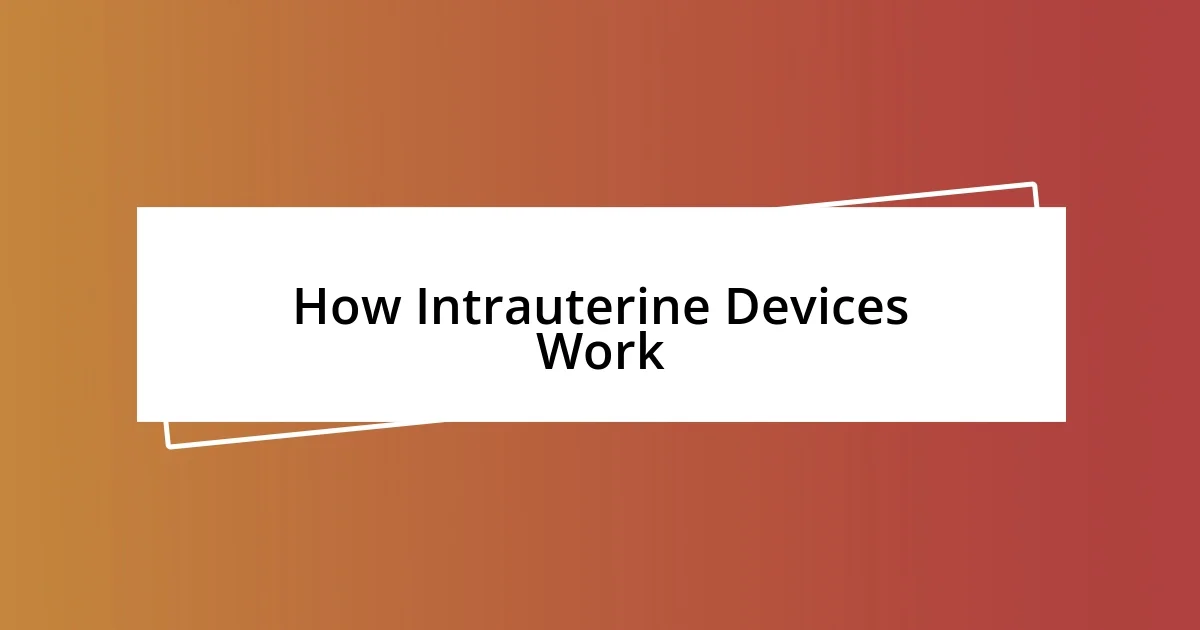
How Intrauterine Devices Work
Intrauterine devices work primarily by preventing sperm from fertilizing an egg. When inserted, an IUD creates a local inflammatory reaction in the uterus, which is hostile to sperm, effectively hindering their journey. I remember discussing this mechanism with a healthcare professional who described it like a security system, where the IUD sets up barriers to keep unwanted guests out.
For hormonal IUDs, the primary action is the release of progestin, a hormone that thickens cervical mucus and thins the uterine lining. This hormonal change not only blocks sperm but can also reduce menstrual flow and cramps. I recall a colleague sharing her experience; she was amazed to find that her heavy periods eased significantly soon after getting her hormonal IUD, highlighting how these devices can adapt to women’s various health needs.
Non-hormonal IUDs, on the other hand, often contain copper, which is toxic to sperm. This copper mechanism prevents fertilization and can even inhibit implantation if fertilization occurs. I spoke with a friend who chose the copper IUD after hearing about its effectiveness; she appreciated its chemical-free approach and felt reassured that it would provide long-term protection without altering her hormone levels.
| Type of IUD | How It Works |
|---|---|
| Hormonal IUD | Releases progestin, thins uterine lining, thickens cervical mucus |
| Non-Hormonal (Copper) IUD | Releases copper ions, creating an environment toxic to sperm |
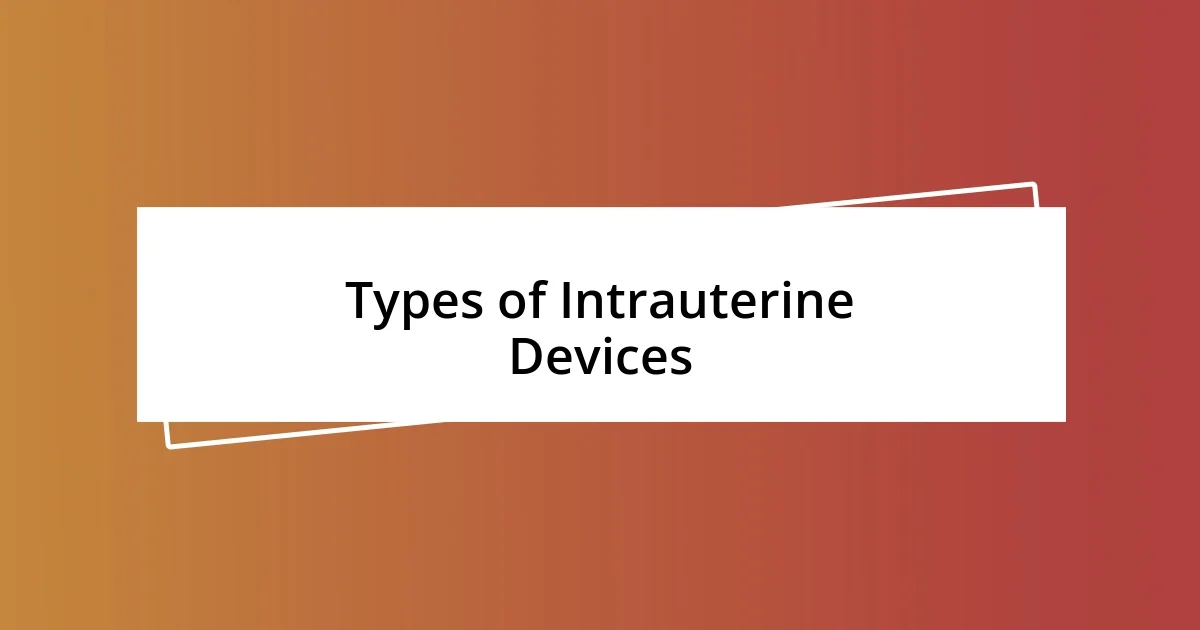
Types of Intrauterine Devices
There are two main types of intrauterine devices: hormonal IUDs and non-hormonal (copper) IUDs. Each offers unique benefits that cater to personal preferences and health considerations. I distinctly remember a conversation with a friend who chose a hormonal IUD because she wanted relief from her heavy periods. In her case, this device didn’t just prevent pregnancy; it also significantly improved her quality of life by reducing menstrual discomfort.
-
Hormonal IUD: Releases progestin, which thickens cervical mucus and thins the uterine lining, often leading to lighter periods.
-
Non-Hormonal (Copper) IUD: Utilizes copper ions to create a hostile environment for sperm, preventing fertilization without altering hormone levels.
Interestingly, the choice between these two options often feels personal. I also encountered someone who opted for a copper IUD after learning about its non-hormonal nature. She shared how she felt empowered by her decision, knowing she wasn’t introducing additional hormones into her system. Her story reinforced my belief that understanding the types of IUDs available can lead to more informed, confident choices.
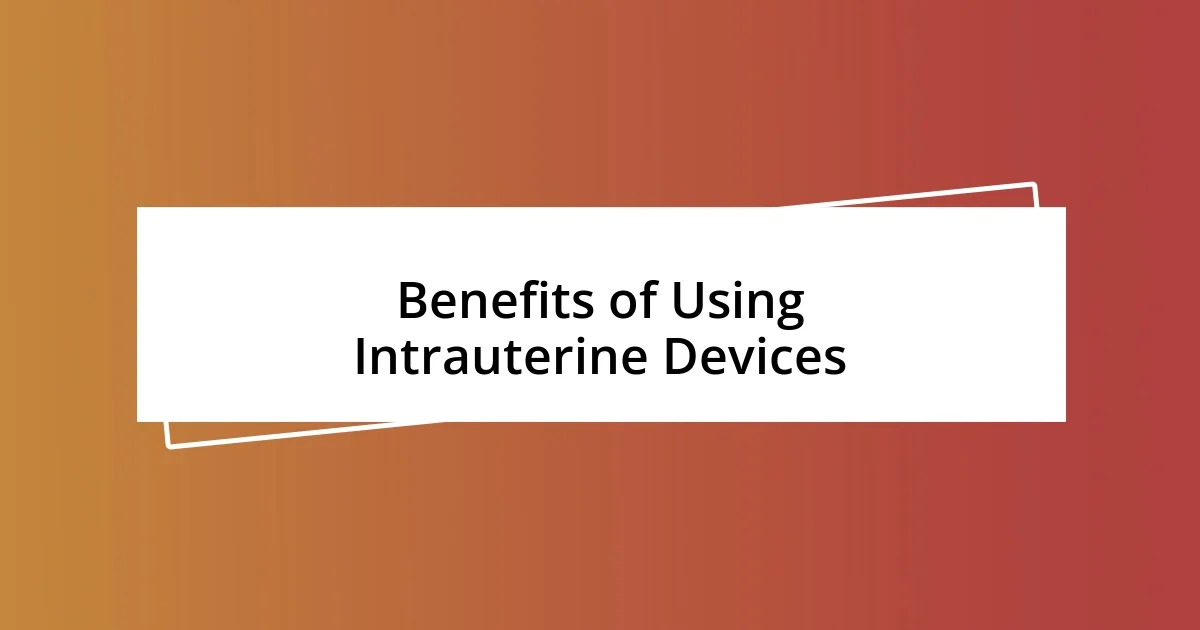
Benefits of Using Intrauterine Devices
The benefits of using intrauterine devices (IUDs) are often profound and personal for many women. One major advantage I’ve noticed is their incredible effectiveness; I recall chatting with a friend who had been struggling with different contraceptive methods. Once she switched to an IUD, the peace of mind she experienced knowing she was protected for several years was life-changing. Who wouldn’t want that kind of convenience?
Another significant benefit is the potential for reduced menstrual symptoms, especially with hormonal IUDs. I remember hearing a testimonial from a coworker who noted how her cramps diminished dramatically after getting her device. She remarked that it wasn’t just about preventing pregnancy; it felt liberating to reclaim those days of discomfort. Isn’t it amazing how a small device can lead to such a big difference in one’s quality of life?
IUDs are also low-maintenance; once they’re in place, there’s little to think about. I recall my own experience with scheduling check-ups after getting mine. The relief of not worrying about daily pills or remembering appointments for more invasive procedures was refreshing. It made me question: why wouldn’t someone consider this long-term solution?
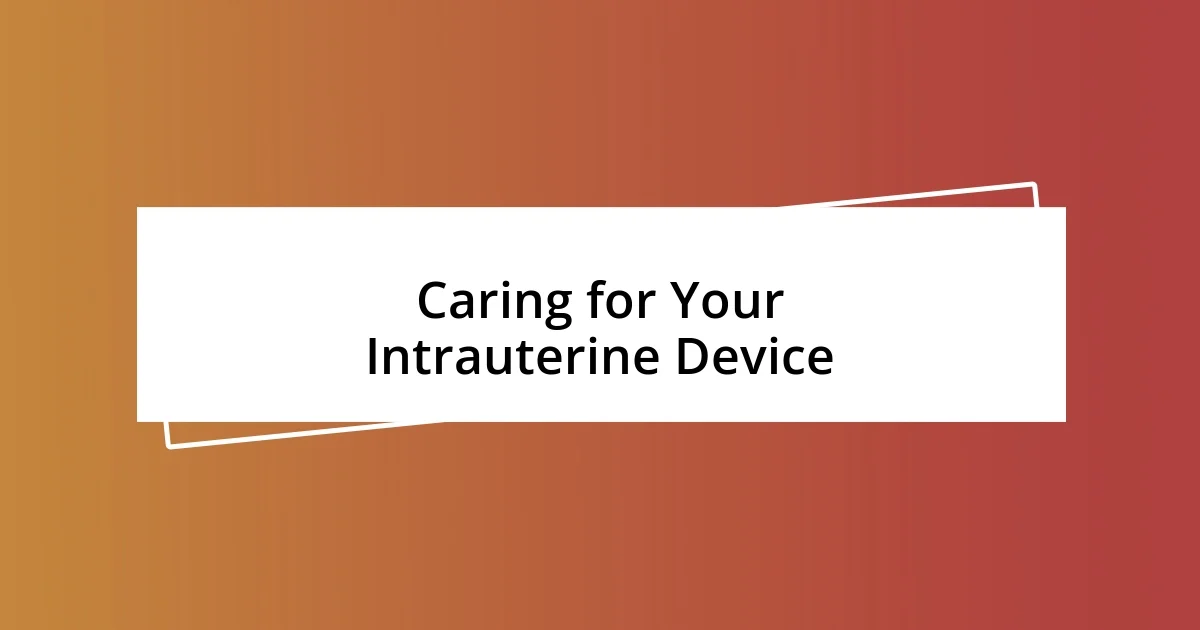
Caring for Your Intrauterine Device
Caring for your intrauterine device (IUD) is essential for ensuring its effectiveness and your overall comfort. I vividly remember my first few weeks with an IUD; I was diligent about checking the strings regularly, as my healthcare provider advised. I found a routine that worked—each month, just a quick tactile reminder that everything was as it should be. It’s a simple yet vital practice that brings a sense of reassurance.
Understanding when to seek professional help is crucial. I once had a moment of concern when I started experiencing unexpected discomfort. I didn’t hesitate to reach out to my healthcare provider, who offered guidance and reassurance, putting my mind at ease. If something feels off—whether it’s unusual pain or changes in your bleeding patterns—trust your instincts and get in touch with a medical professional. Better safe than sorry, right?
Maintaining follow-up appointments is also a key part of IUD care. I remember scheduling my yearly check-up felt like a small task compared to all the peace of mind my IUD provided. These appointments allow your healthcare provider to ensure everything is in place. Plus, I loved using them as a chance to discuss any concerns I had while embracing this journey toward effective contraception. It reinforced for me that proactive care leads to a smoother experience.
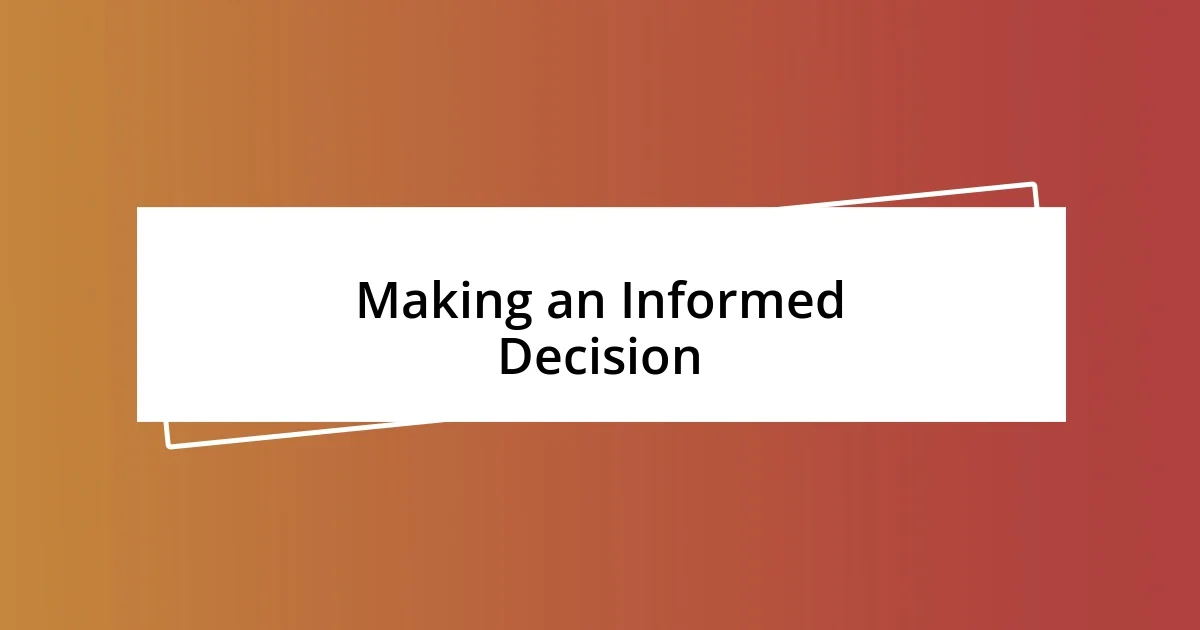
Making an Informed Decision
Making a well-informed decision about getting an IUD is crucial, and it’s important to weigh both the benefits and any potential drawbacks. I remember sitting down to reflect on my choices before getting mine; it felt a bit overwhelming at first. I asked myself, what do I truly want from my contraceptive method? Exploring options makes such a difference in feeling confident about your choice.
I found it really helpful to gather information from trustworthy sources. Talking with my healthcare provider was key to addressing my concerns; I felt empowered after our conversation. They walked me through the process and demystified some common misconceptions. Isn’t it comforting to know you can have an open dialogue about your body and your choices?
Another aspect I think is vital is considering your lifestyle and future plans. After deep thought, I realized that an IUD aligned well with my long-term goals, especially since I wasn’t ready for children. Every individual’s circumstances are unique; what works for one person may not be right for another. Have you thought about how an IUD might fit into your own life right now? Taking the time to reflect can lead to truly informed decision-making.
